Optimizing Energy and Cost Performance in Residential Buildings: A Multi-Objective Approach Applied to the City of Patras, Greece
Abstract
1. Introduction
2. Simulation-Based Approaches to Multi-Objective Energy Optimization in Buildings
2.1. Classification of Simulation-Based Optimization Methods
2.2. Integration of Simulation and Optimization: Methods and Applications
2.3. Real-World Case Studies
3. Methodology
3.1. Climatic Context and Building Description
3.2. Optimization Framework
3.2.1. Objective Functions
3.2.2. Design Variables
4. Results and Discussion
5. Concluding Remarks and Future Directions
Author Contributions
Funding
Data Availability Statement
Conflicts of Interest
Abbreviations
| ACO | Ant Colony Optimization |
| BPS | Building Performance Simulation |
| GA | Genetic Algorithm |
| GHG | Greenhouse Gas |
| HDD | Heating Degree Days |
| HVAC | Heating, Ventilation and Air Conditioning |
| IP | Integer Programming |
| LCC | Life-Cycle Cost |
| LP | Linear Programming |
| ML | Machine Learning |
| MOGA | Multi Objective Genetic Algorithm |
| NLP | Non-linear Programming |
| NOA | National Observatory of Athens |
| NSGA-II | Non-dominated Sorting Genetic Algorithm II |
| PMV | Predicted Mean Vote |
| PSO | Particle Swarm Optimization |
| SA | Simulated Annealing |
| SBO | Simulation-Based Optimization |
References
- International Energy Agency. Global Status Report for Buildings and Construction; License: CC BY 4.0.; International Energy Agency: Paris, France, 2019; Available online: https://www.iea.org/reports/global-status-report-for-buildings-and-construction-2019 (accessed on 3 February 2025).
- Santamouris, M.; Vasilakopoulou, K. Present and future energy consumption of buildings: Challenges and opportunities towards decarbonization. E-Prime—Adv. Electr. Eng. Electron. Energy 2021, 1, 100002. [Google Scholar] [CrossRef]
- Mihalakakou, G.; Souliotis, M.; Papadaki, M.; Halkos, G.; Paravantis, J.; Makridis, S.; Papaefthimiou, S. Applications of earth-to-air heat exchangers: A holistic review. Renew. Sustain. Energy Rev. 2022, 155, 111921. [Google Scholar] [CrossRef]
- Mihalakakou, G.; Souliotis, M.; Papadaki, M.; Menounou, P.; Dimopoulos, P.; Kolokotsa, D.; Paravantis, J.A.; Tsangrassoulis, A.; Panaras, G.; Giannakopoulos, E.; et al. Green roofs as a nature-based solution for improving urban sustainability: Progress and perspectives. Renew. Sustain. Energy Rev. 2023, 180, 113306. [Google Scholar] [CrossRef]
- Chwieduk, D.A. Towards modern options of energy conservation in buildings. Renew. Energy 2017, 101, 1194–1202. [Google Scholar] [CrossRef]
- Cao, X.; Dai, X.; Liu, J. Building energy-consumption status worldwide and the state-of-the-art technologies for zero-energy buildings during the past decade. Energy Build. 2016, 128, 198–213. [Google Scholar] [CrossRef]
- Tombazis, A.N.; Preuss, S.A. Design of passive solar building in urban areas. Sol. Energy 2001, 70, 311–318. [Google Scholar] [CrossRef]
- Athienitis, A.K. Thermal Analysis and Design of Passive Solar Buildings, 1st ed.; Routledge: London, UK, 2001. [Google Scholar] [CrossRef]
- Kappou, S.; Souliotis, M.; Papaefthimiou, S.; Panaras, G.; Paravantis, J.A.; Michalena, E.; Hills, J.M.; Vouros, A.P.; Dimenou, K.; Mihalakakou, G. Review Cool Pavements: State of the Art and New Technologies. Sustainability 2022, 14, 5159. [Google Scholar] [CrossRef]
- Giannadakis, A.; Romeos, A.; Kalogirou, I.; Dimopoulos, D.I.; Trachanas, G.P.; Marinakis, V.; Mihalakakou, G. Energy performance analysis of a passive house building. Energy Sources Part B Econ. Plan. Policy 2025, 20, 2455114. [Google Scholar] [CrossRef]
- Nielsen, T.R. Optimization of Buildings with Respect to Energy and Indoor Environment. Ph.D. Thesis, Technical University of Denmark, Lyngby, Denmark, 2003. Byg Rapport No. R-036. [Google Scholar]
- Machairas, V.; Tsangrassoulis, A.; Axarli, K. Algorithms for optimization of building design: A review. Renew. Sustain. Energy Rev. 2014, 31, 101–112. [Google Scholar] [CrossRef]
- Rothlauf, F. Design of Modern Heuristics, 1st ed.; Springer: Berlin/Heidelberg, Germany, 2011. [Google Scholar] [CrossRef]
- Wetter, M. GenOpt—A Generic Optimization Program. Seventh Int. IBPSA Conf. 2001, 7, 601–608. [Google Scholar] [CrossRef]
- Hwang, C.L.; Masud, A.S. Multiple Objective Decision Making—Methods and Applications; Springer: Berlin/Heidelberg, Germany, 1979. [Google Scholar]
- Qian, N. On the momentum term in gradient descent learning algorithms. Neural Netw. 1999, 12, 145–151. [Google Scholar] [CrossRef] [PubMed]
- Ahmed, H.I.; Hamed, E.T.; Chilmeran, H.T.S. A Modified Bat Algorithm with Conjugate Gradient Method for Global Optimization. Int. J. Math. Math. Sci. 2020, 2020, 4795793. [Google Scholar] [CrossRef]
- Nayak, S. Fundamentals of Optimization Techniques with Algorithms, 1st ed.; Elsevier: Amsterdam, The Netherlands, 2021. [Google Scholar] [CrossRef]
- Chelouah, R.; Siarry, P. Tabu search applied to global optimization. Eur. J. Oper. Res. 2000, 123, 256–270. [Google Scholar] [CrossRef]
- Hooke, R.; Jeeves, T.A. “Direct Search” Solution of Numerical and Statistical Problems. J. ACM 1961, 8, 212–229. [Google Scholar] [CrossRef]
- Kolda, T.G.; Lewis, R.M.; Torczon, V. Optimization by Direct Search: New Perspectives on Some Classical and Modern Methods. Soc. Ind. Apllied Math. 2003, 45, 385–482. [Google Scholar] [CrossRef]
- Kheiri, F. A review on optimization methods applied in energy-efficient building geometry and envelope design. Renew. Sustain. Energy Rev. 2018, 92, 897–920. [Google Scholar] [CrossRef]
- Gero, J.S.; D’Cruz, N.; Radford, A.D. Energy in context: A multicriteria model for building design. Build. Environ. 1983, 18, 99–107. [Google Scholar] [CrossRef]
- Heiselberg, P.; Brohus, H.; Hesselholt, A.; Rasmussen, H.; Seinre, E.; Thomas, S. Application of sensitivity analysis in design of sustainable buildings. Renew. Energy 2009, 34, 2030–2036. [Google Scholar] [CrossRef]
- Huang, Y.; Niu, J.L. Optimal building envelope design based on simulated performance: History, current status and new potentials. Energy Build. 2016, 117, 387–398. [Google Scholar] [CrossRef]
- Gan, V.J.L.; Lo, I.M.C.; Ma, J.; Tse, K.T.; Cheng, J.C.P.; Chan, C.M. Simulation optimisation towards energy efficient green buildings: Current status and future trends. J. Clean. Prod. 2020, 254, 120012. [Google Scholar] [CrossRef]
- Deb, C.; Zhang, F.; Yang, J.; Lee, S.E.; Shah, K.W. A review on time series forecasting techniques for Building energy consumption. Renew. Sustain. Energy Rev. 2017, 74, 902–924. [Google Scholar] [CrossRef]
- Shi, G.; Liu, D.; Wei, Q. Prediction of energy consumption in office buildings based on echo state network. In Proceedings of the 2016 12th World Congress on Intelligent Control and Automation (WCICA), Guilin, China, 12–15 June 2016; Volume 2016-Septe, pp. 895–899. [Google Scholar] [CrossRef]
- Nguyen, A.T.; Reiter, S.; Rigo, P. A review on simulation-based optimization methods applied to building performance analysis. Appl. Energy 2014, 113, 1043–1058. [Google Scholar] [CrossRef]
- MATLAB; Version R2024a; MathWorks: Natick, MA, USA, 2024; Available online: https://www.mathworks.com (accessed on 20 October 2024).
- U.S. Department of Energy. Energy Plus: Weather Data. 2024. Available online: https://energyplus.net/weather (accessed on 4 May 2025).
- Klein, S.A. TRNSYS 18: A Transient System Simulation Program. 2017. Available online: http://sel.me.wisc.edu/trnsys (accessed on 4 May 2025).
- Wright, J.A.; Loosemore, H.A.; Farmani, R. Optimization of building thermal design and control by multi-criterion genetic algorithm. Energy Build. 2002, 34, 959–972. [Google Scholar] [CrossRef]
- Attia, S.; Hamdy, M.; O’Brien, W.; Carlucci, S. Assessing gaps and needs for integrating building performance optimization tools in net zero energy buildings design. Energy Build. 2013, 60, 110–124. [Google Scholar] [CrossRef]
- Al Mindeel, T.; Spentzou, E.; Eftekhari, M. Energy, thermal comfort, and indoor air quality: Multi-objective optimization review. Renew. Sustain. Energy Rev. 2024, 202, 114682. [Google Scholar] [CrossRef]
- Evins, R. A review of computational optimisation methods applied to sustainable building design. Renew. Sustain. Energy Rev. 2013, 22, 230–245. [Google Scholar] [CrossRef]
- Branke, J.S.R.; Deb, K.; Miettinen, K. Multi-Objective Optimization: Interactive and Evolutionary Approaches, 1st ed.; Springer: Berlin/Heidelberg, Germany, 2008. [Google Scholar] [CrossRef]
- Goldberg, D.E. Genetic Algorithms in Search, Optimization, and Machine Learning; Addison-Wesley Professional: Boston, MA, USA, 1989. [Google Scholar]
- Taveres-Cachat, E.; Goia, F. Exploring the impact of problem formulation in numerical optimization: A case study of the design of PV integrated shading systems. Build. Environ. 2021, 188, 107422. [Google Scholar] [CrossRef]
- Nocedal, J.; Wright, S.J. Numerical Optimization, 2nd ed.; Springer Series in Operations Research and Financial Engineering; Springer: Berlin/Heidelberg, Germany, 2006. [Google Scholar] [CrossRef]
- Chanas, S.; Zieliński, P. On the equivalence of two optimization methods for fuzzy linear programming problems. Eur. J. Oper. Res. 2000, 121, 56–63. [Google Scholar] [CrossRef]
- Swann, W.H. A survey of non-linear optimization techniques. FEBS Lett. 1969, 2, S39–S55. [Google Scholar] [CrossRef]
- Wolsey, L. Integer Programming; John Wiley & Sons: Hoboken, NJ, USA, 2020. [Google Scholar] [CrossRef]
- Deb, K.; Pratap, A.; Agarwal, S.; Meyarivan, T. A fast and elitist multiobjective genetic algorithm: NSGA-II. IEEE Trans. Evol. Comput. 2002, 6, 182–197. [Google Scholar] [CrossRef]
- Kennedy, J.; Eberhart, R. Particle swarm optimization. In Proceedings of the ICNN’95—International Conference on Neural Networks, Perth, WA, Australia, 27 November–1 December 1995; pp. 1942–1948. [Google Scholar] [CrossRef]
- Dorigo, M.; Maniezzo, V.; Colorni, A. Ant system: Optimization by a colony of cooperating agents. IEEE Trans. Syst. Man Cybern. Part B (Cybern.) 1996, 26, 29–41. [Google Scholar] [CrossRef] [PubMed]
- Deb, K. Multi-Objective Optimization Using Evolutionary Algorithms; John Wiley & Sons: Hoboken, NJ, USA, 2001. [Google Scholar]
- Eiben, A.E.; Smith, J.E. Introduction to Evolutionary Computing: Natural Computing Series, 2nd ed.; Springer: Berlin/Heidelberg, Germany, 2015. [Google Scholar] [CrossRef]
- Kegl, M.; Butinar, B.J.; Kegl, B. An efficient gradient-based optimization algorithm for mechanical systems. Numer. Methods Biomed. Eng. 2002, 18, 363–371. [Google Scholar] [CrossRef]
- Yang, X.-S. Nature-Inspired Optimization Algorithms; Elsevier: Amsterdam, The Netherlands, 2014. [Google Scholar]
- Asadi, E.; Silva, M.G.; Antunes, C.H.; Dias, L.; Glicksman, L. Multi-objective optimization for building retrofit: A model using genetic algorithm and artificial neural network and an application. Energy Build. 2014, 81, 444–456. [Google Scholar] [CrossRef]
- Attia, S.; Hamdy, M.; O’Brien, W.; Carlucci, S. Computational optimisation for zero energy buildings design: Interviews results with twenty eight international experts. In Proceedings of the BS 2013 13th Conference of International Building Performance Simulation Association, Chambéry, France, 26–28 August 2013; pp. 3698–3705. [Google Scholar] [CrossRef]
- Arani, S. Optimizing Energy Performance of Building Renovation Using Traditional and Machine Learning Approaches. Ph.D. Thesis, Concordia University, Montreal, QC, Canada, 2020. [Google Scholar]
- Russell, A.D.; Arlani, G.A. Objective functions for optimal building design. Comput. Des. 1981, 13, 327–338. [Google Scholar] [CrossRef]
- Benaddi, F.Z.; Boukhattem, L.; Tabares-Velasco, P.C. Multi-objective optimization of building envelope components based on economic, environmental, and thermal comfort criteria. Energy Build. 2024, 305, 113909. [Google Scholar] [CrossRef]
- Delgarm, N.; Sajadi, B.; Kowsary, F.; Delgarm, S. Multi-objective optimization of the building energy performance: A simulation-based approach by means of particle swarm optimization (PSO). Appl. Energy 2016, 170, 293–303. [Google Scholar] [CrossRef]
- Sharif, S.A.; Hammad, A. Simulation-Based Multi-Objective Optimization of institutional building renovation considering energy consumption, Life-Cycle Cost and Life-Cycle Assessment. J. Build. Eng. 2019, 21, 429–445. [Google Scholar] [CrossRef]
- Chantrelle, F.P.; Lahmidi, H.; Keilholz, W.; El Mankibi, M.; Michel, P. Development of a multicriteria tool for optimizing the renovation of buildings. Appl. Energy 2011, 88, 1386–1394. [Google Scholar] [CrossRef]
- Evins, R.; Pointer, P.; Vaidyanathan, R.; Burgess, S. A case study exploring regulated energy use in domestic buildings using design-of-experiments and multi-objective optimization. Build. Environ. 2012, 54, 126–136. [Google Scholar] [CrossRef]
- Ferrara, M.; Fabrizio, E.; Virgone, J.; Filippi, M. A simulation-based optimization method for cost-optimal analysis of nearly Zero Energy Buildings. Energy Build. 2014, 84, 442–457. [Google Scholar] [CrossRef]
- Sahu, M.; Bhattacharjee, B.; Kaushik, S.C. Thermal design of air-conditioned building for tropical climate using admittance method and genetic algorithm. Energy Build. 2012, 53, 1–6. [Google Scholar] [CrossRef]
- Wang, W.; Rivard, H.; Zmeureanu, R. An object-oriented framework for simulation-based green building design optimization with genetic algorithms. Adv. Eng. Inform. 2005, 19, 5–23. [Google Scholar] [CrossRef]
- Junghans, L.; Darde, N. Hybrid single objective genetic algorithm coupled with the simulated annealing optimization method for building optimization. Energy Build. 2015, 86, 651–662. [Google Scholar] [CrossRef]
- Bichiou, Y.; Krarti, M. Optimization of envelope and HVAC systems selection for residential buildings. Energy Build. 2011, 43, 3373–3382. [Google Scholar] [CrossRef]
- Sarmas, E.; Dimitropoulos, N.; Strompolas, S.; Mylona, Z.; Marinakis, V.; Giannadakis, A.; Romaios, A.; Doukas, H. A web-based Building Automation and Control Service. In Proceedings of the 2022 13th International Conference on Information, Intelligence, Systems & Applications (IISA), Corfu, Greece, 18–20 July 2022; p. 22095409. [Google Scholar] [CrossRef]
- Juan, Y.K.; Gao, P.; Wang, J. A hybrid decision support system for sustainable office building renovation and energy performance improvement. Energy Build. 2010, 42, 290–297. [Google Scholar] [CrossRef]
- Penna, P.; Prada, A.; Cappelletti, F.; Gasparella, A. Multi-objectives optimization of Energy Efficiency Measures in existing buildings. Energy Build. 2015, 95, 57–69. [Google Scholar] [CrossRef]
- Khani, A.; Khakzand, M.; Faizi, M. Multi-objective optimization for energy consumption, visual and thermal comfort performance of educational building (case study: Qeshm Island, Iran). Sustain. Energy Technol. Assess. 2022, 54, 102872. [Google Scholar] [CrossRef]
- Bolattürk, A. Optimum insulation thicknesses for building walls with respect to cooling and heating degree-hours in the warmest zone of Turkey. Build. Environ. 2008, 43, 1055–1064. [Google Scholar] [CrossRef]
- Bolattürk, A. Determination of optimum insulation thickness for building walls with respect to various fuels and climate zones in Turkey. Appl. Therm. Eng. 2006, 26, 1301–1309. [Google Scholar] [CrossRef]
- Wang, W.; Zmeureanu, R.; Rivard, H. Applying multi-objective genetic algorithms in green building design optimization. Build. Environ. 2005, 40, 1512–1525. [Google Scholar] [CrossRef]
- Hamdy, M.; Nguyen, A.T.; Hensen, J.L.M. A performance comparison of multi-objective optimization algorithms for solving nearly-zero-energy-building design problems. Energy Build. 2016, 121, 57–71. [Google Scholar] [CrossRef]
- National Observatory of Athens (NOA). Institute for Environmental Research and Sustainable Development. Available online: https://www.iersd.noa.gr/en/ (accessed on 4 May 2025).
- Kreider, J.F.; Rabl, A. Heating and Cooling of Buildings: Design for Efficiency; McGraw-Hill: New York, NY, USA, 1994. [Google Scholar]
- Karagiannidis, A.; Lagouvardos, K.; Kotroni, V.; Galanaki, E. Analysis of Current and Future Heating and Cooling Degree Days over Greece Using Observations and Regional Climate Model Simulations. Environ. Sci. Proc. 2023, 26, 149. [Google Scholar] [CrossRef]
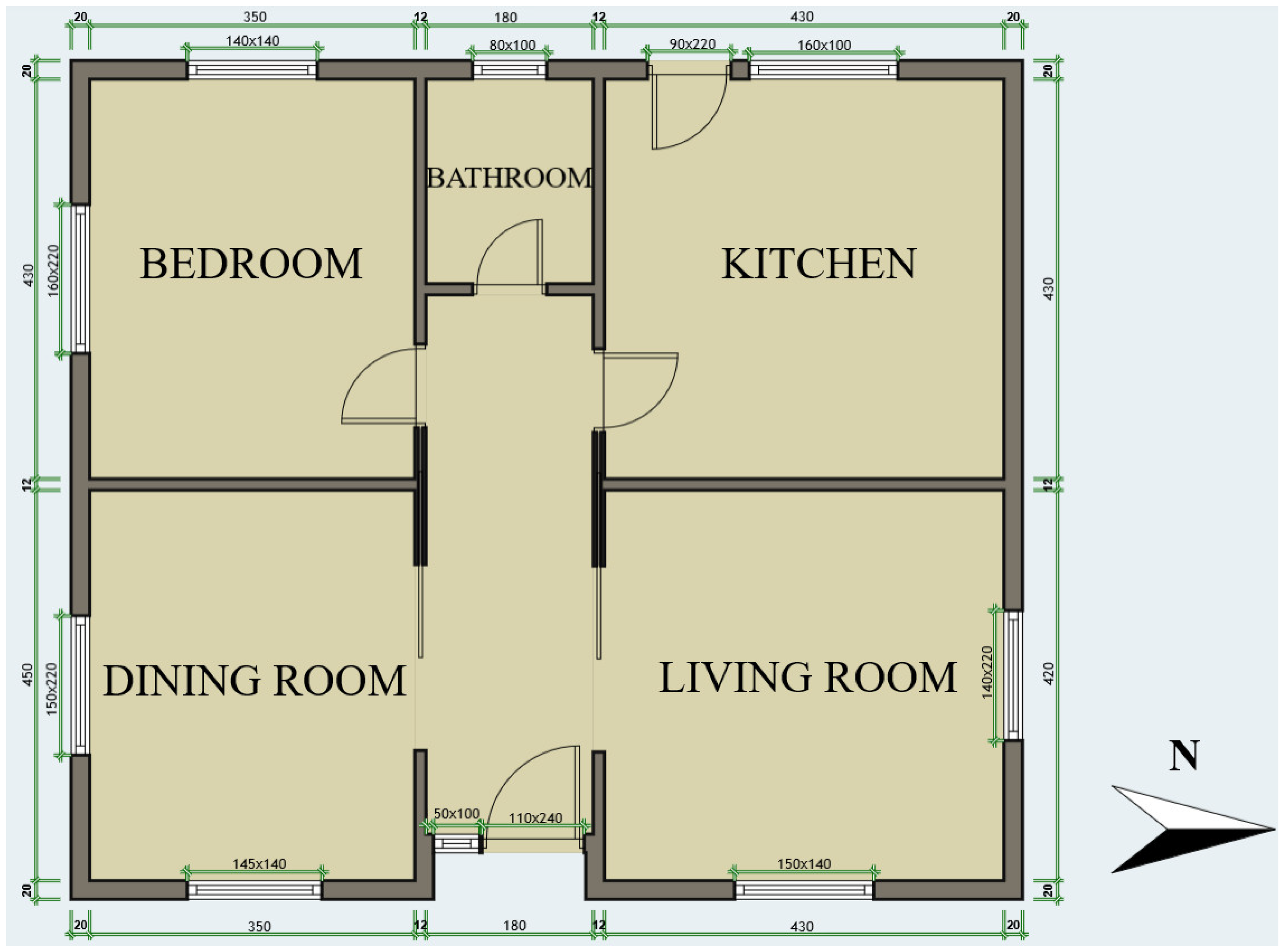
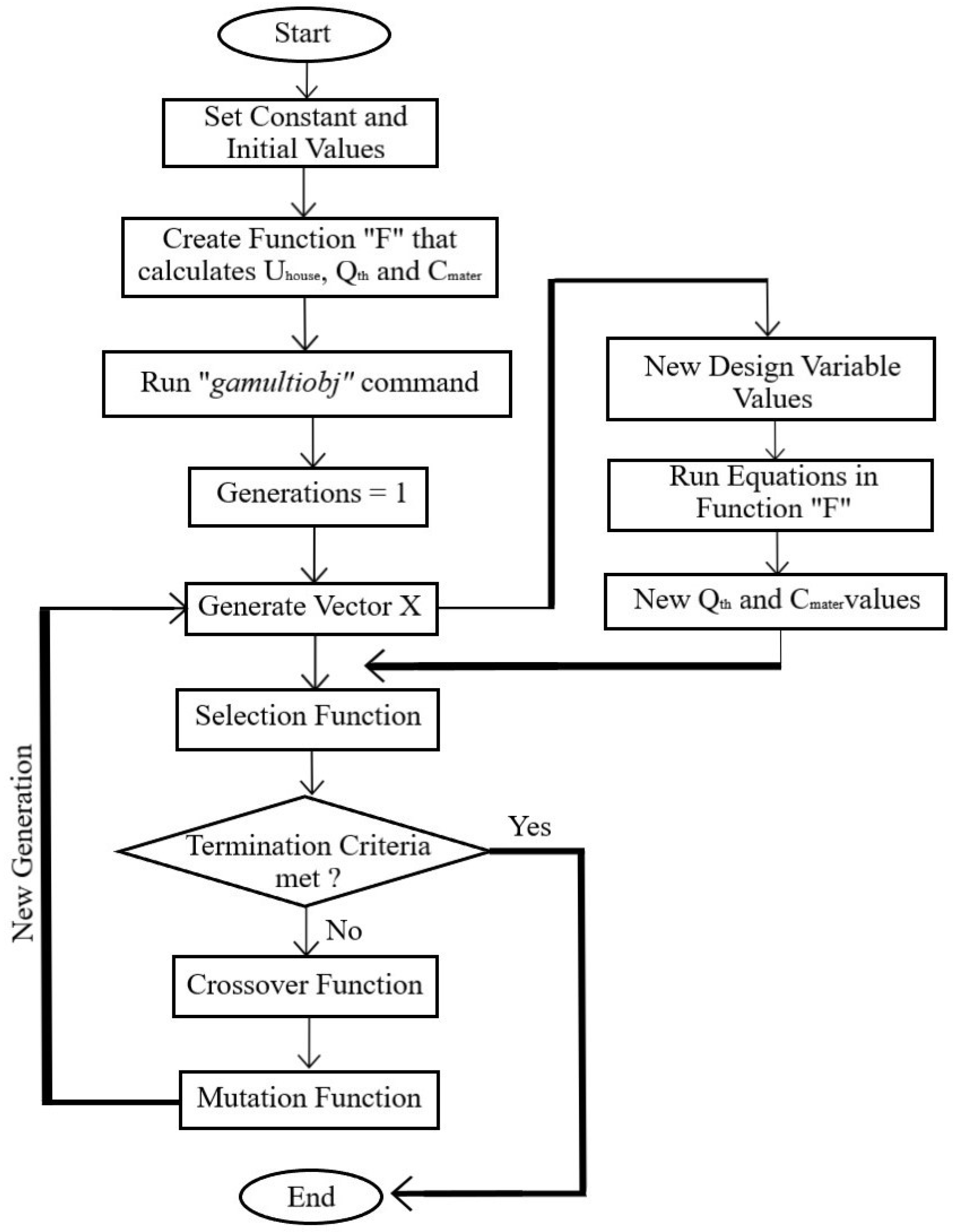
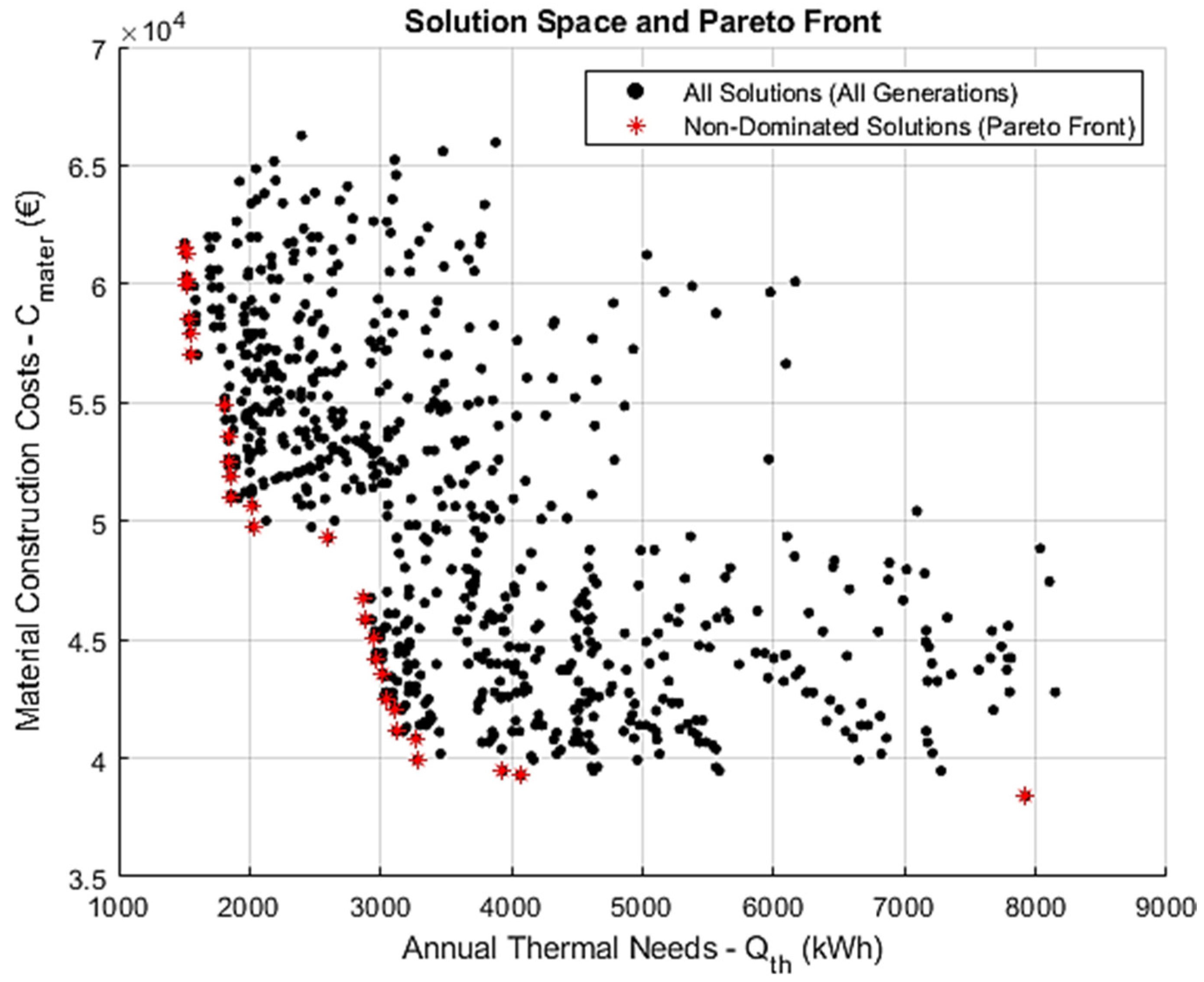
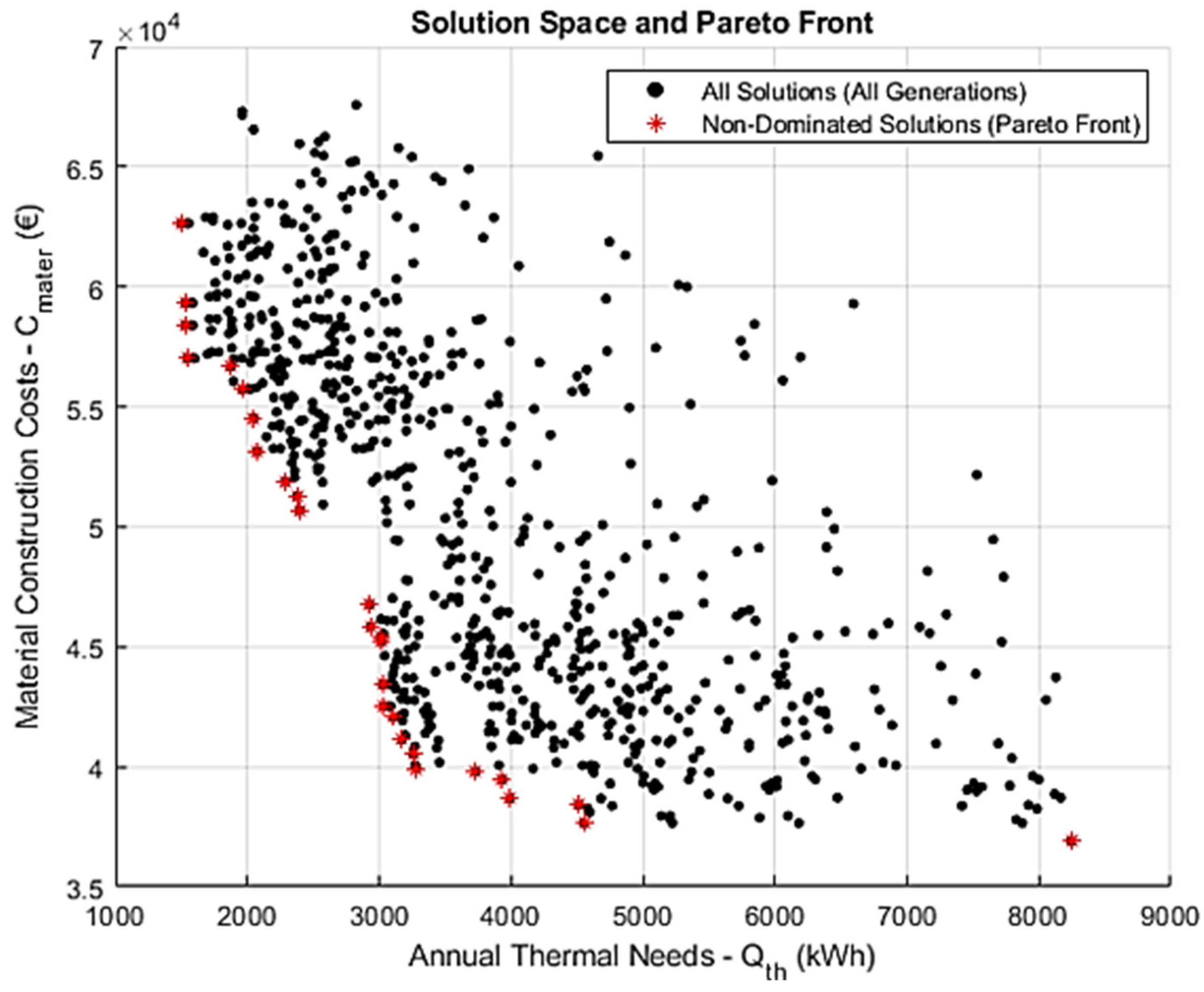
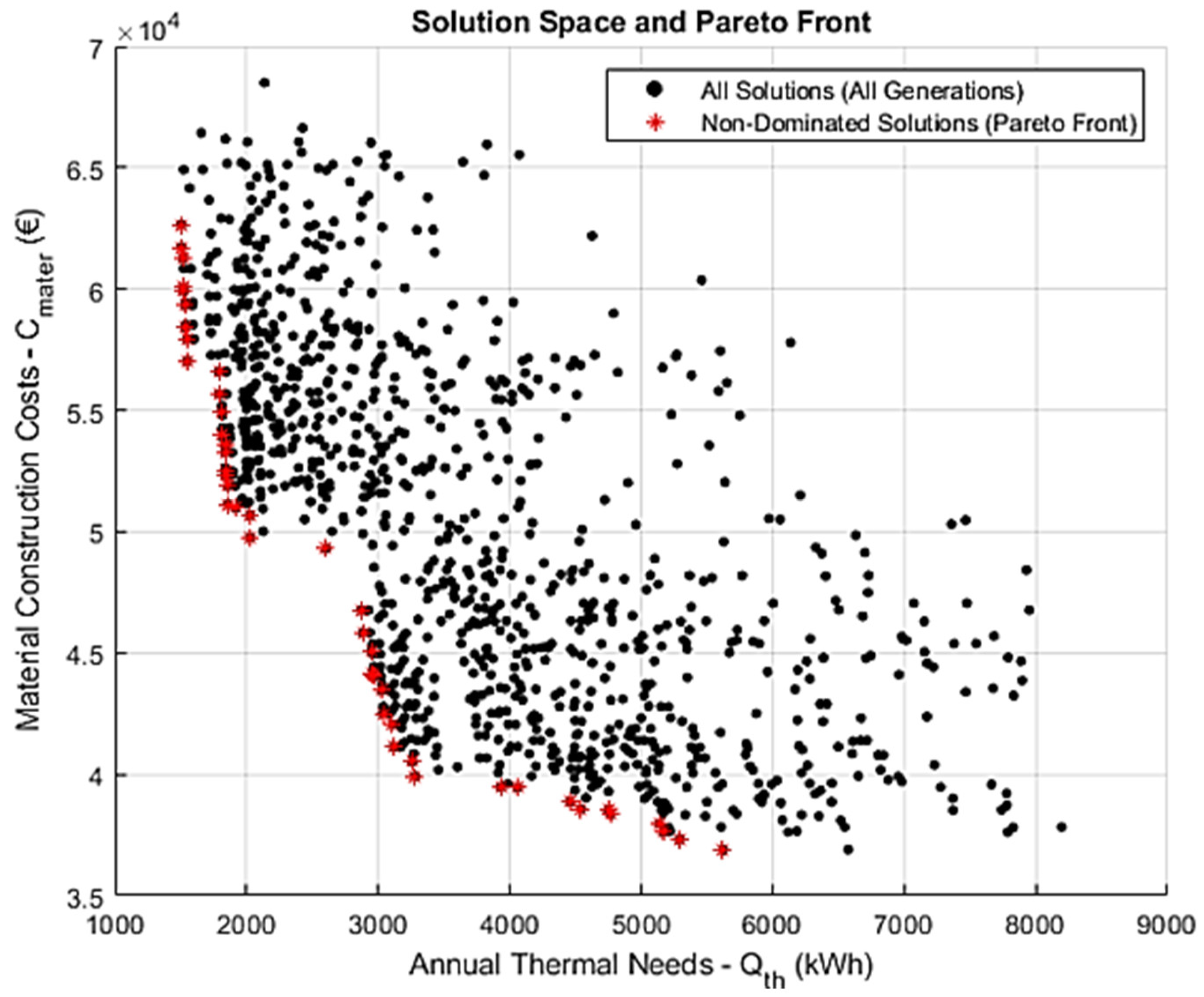
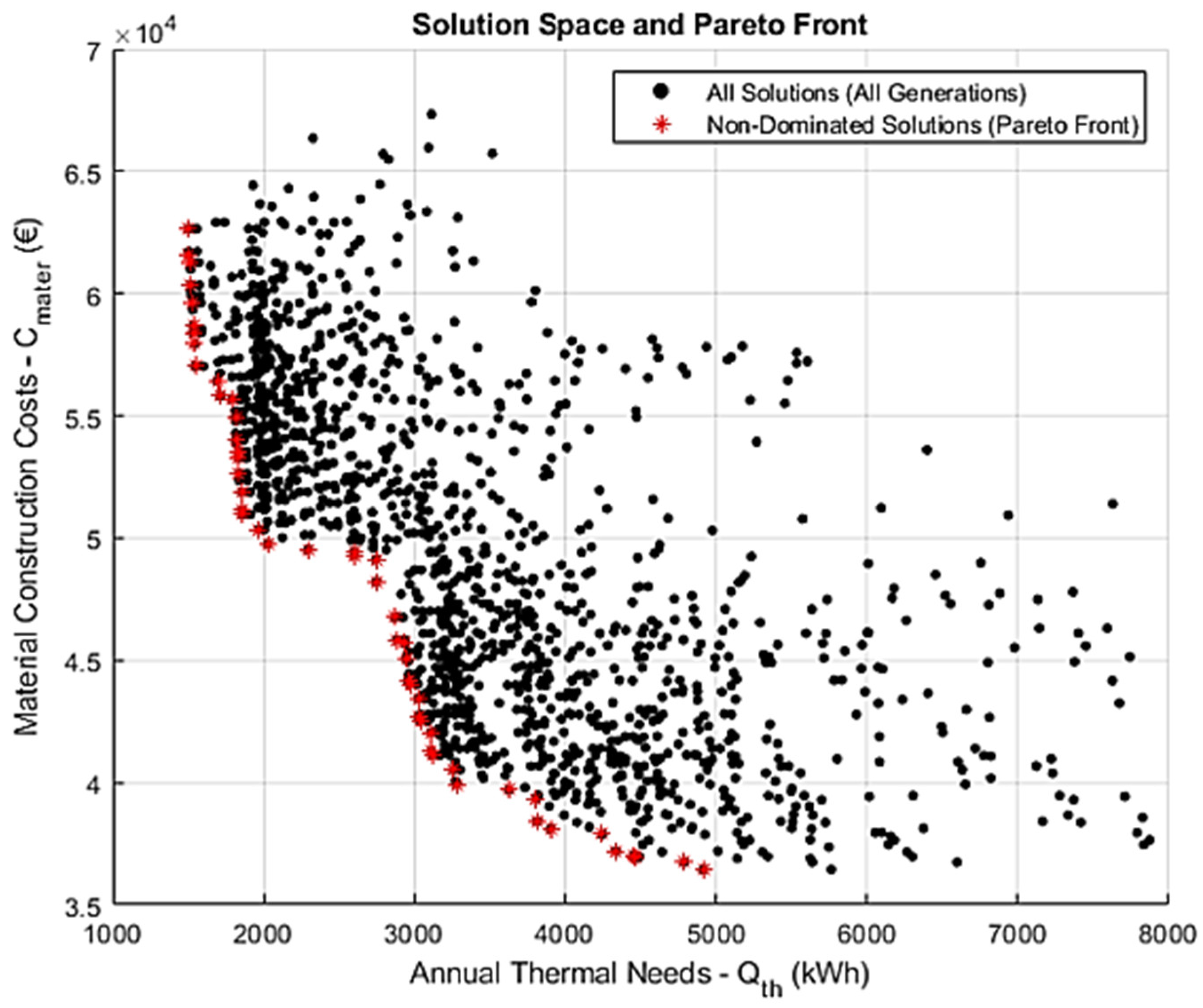
| Month | HDD Value |
|---|---|
| January | 199 |
| February | 156 |
| March | 131 |
| April | 58 |
| May | 10 |
| June | 0 |
| July | 0 |
| August | 0 |
| September | 2 |
| October | 11 |
| November | 50 |
| December | 149 |
| Total (annual) | 766 |
| Building Element | Area (m2) |
|---|---|
| Floor, roof | 92.36 |
| Walls | 85.06 |
| Windows | 18.89 |
| Doors | 4.62 |
| Internal walls | 65.75 |
| Design Variable | Symbol | Units | Value Range | Description |
|---|---|---|---|---|
| Thermal Transmittance of Roof | Uroof | W/m2·K | 2.22–3.26 | Based on selected roof construction materials (Reinforced Concrete, and Pitched with Tiles) |
| Thermal Transmittance of Floor | Ufloor | W/m2·K | 2.46–2.68 | Depends on floor choice (Wooden, Marble) |
| Thermal Transmittance of Walls | Uwalls | W/m2·K | 0.47–5.8 | Affected by wall thickness and insulation |
| Thermal Transmittance of Windows | Uwin | W/m2·K | 1.40–2.68 | Depends on glazing type and frame material (Single, Double, Triple Glaze, Air, Krypton, Argon, Vacuum-Filled, with/without Low-E Film, PVC, Wooden, Metal Frames |
| Thermal Transmittance of Doors | Udoor | W/m2·K | 0.84–6.98 | Based on door type (Wooden, Aluminum, Metal (with/without Thermal Break) |
| Thermal Transmittance of Insulation Material | Uins | W/m2·K | 0.23–2.17 | Polystyrene (EPS), Graphite Polystyrene (GEPS), Extruded Polystyrene (XPS), Mineral Wool, Cork and Polyurethane |
| Specific Cost of Roof Material | Croof | EUR/m2 | 55–70 | Matched to thermal performance |
| Specific Cost of Floor Material | Cfloor | EUR/m2 | 60–70 | Corresponds to selected floor type |
| Specific Cost of Wall Material | Cwalls | EUR/m2 | 160–780 | Depends on wall assembly and insulation |
| Specific Cost of Window | Cwin | EUR/m2 | 23–45 | Includes glazing and frame selection |
| Specific Cost of Doors | Cdoors | EUR | 1160–1880 | One-time cost (not per area) based on door type |
| Specific Cost of Insulation Material | Cins | EUR/m2 | 11.7–70.6 | Linked to insulation thermal performance |
| Scenario | Population Size | Max Genarations | Mutation Rate |
|---|---|---|---|
| 1 | 100 | 50 | 0.10 |
| 2 | 100 | 50 | 0.04 |
| 3 | 200 | 50 | 0.04 |
| 4 | 200 | 100 | 0.04 |
| Scenario | Population Size | Max. Generations | Mutation Rate (%) | Execution Time (min) | Non-Dominated Solutions | Observations |
|---|---|---|---|---|---|---|
| 1 | 100 | 50 | 0.10 | 7 | 28 | Baseline configuration, limited diversity, and lower Pareto front coverage |
| 2 | 100 | 50 | 0.04 | 15 | 38 | Reduced mutation rate improves stability and front density modestly. Better distribution than Scenario 1 |
| 3 | 200 | 50 | 0.04 | 30 | 49 | Increasing population size enhances diversity and solution spread |
| 4 | 200 | 100 | 0.04 | 90 | 65 | Best overall performance. High population and generation count yield the most continuous and well-distributed Pareto front |
Disclaimer/Publisher’s Note: The statements, opinions and data contained in all publications are solely those of the individual author(s) and contributor(s) and not of MDPI and/or the editor(s). MDPI and/or the editor(s) disclaim responsibility for any injury to people or property resulting from any ideas, methods, instructions or products referred to in the content. |
© 2025 by the authors. Licensee MDPI, Basel, Switzerland. This article is an open access article distributed under the terms and conditions of the Creative Commons Attribution (CC BY) license (https://creativecommons.org/licenses/by/4.0/).
Share and Cite
Makris, D.; Antzoulatou, A.; Romaios, A.; Malefaki, S.; Paravantis, J.A.; Giannadakis, A.; Mihalakakou, G. Optimizing Energy and Cost Performance in Residential Buildings: A Multi-Objective Approach Applied to the City of Patras, Greece. Energies 2025, 18, 3361. https://doi.org/10.3390/en18133361
Makris D, Antzoulatou A, Romaios A, Malefaki S, Paravantis JA, Giannadakis A, Mihalakakou G. Optimizing Energy and Cost Performance in Residential Buildings: A Multi-Objective Approach Applied to the City of Patras, Greece. Energies. 2025; 18(13):3361. https://doi.org/10.3390/en18133361
Chicago/Turabian StyleMakris, Dionyssis, Anastasia Antzoulatou, Alexandros Romaios, Sonia Malefaki, John A. Paravantis, Athanassios Giannadakis, and Giouli Mihalakakou. 2025. "Optimizing Energy and Cost Performance in Residential Buildings: A Multi-Objective Approach Applied to the City of Patras, Greece" Energies 18, no. 13: 3361. https://doi.org/10.3390/en18133361
APA StyleMakris, D., Antzoulatou, A., Romaios, A., Malefaki, S., Paravantis, J. A., Giannadakis, A., & Mihalakakou, G. (2025). Optimizing Energy and Cost Performance in Residential Buildings: A Multi-Objective Approach Applied to the City of Patras, Greece. Energies, 18(13), 3361. https://doi.org/10.3390/en18133361








